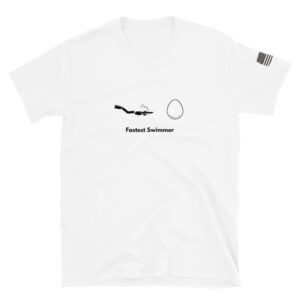Don't miss our flash to bang SALES!
WW2 Project Aphrodite
WWII B-17 Pilot Fain H. Pool discloses “Project Aphrodite”
What was Project Aphrodite?
The U.S. Military would take old, four-engine “War Weary (WW)” B-17 Flying Fortresses and B-24 Liberators and strip them of armor, armament, and all non-essential flight gear — even taking out the radios. This freed up 12,000 pounds of useful load in the four-engine bomber, which would then be packed with an equivalent amount of a new British explosive called Torpex. Pound for pound, Torpex was 50 percent more powerful than TNT. The designers had created a veritable flying bomb.
On August 12, 1944, the eldest son of one of America’s greatest political families, Navy Lieutenant (LT) Joseph P. Kennedy, Jr., the namesake of the family patriarch, was killed over England during World War II. He was part of a special, all-volunteer experimental project called “Operation Aphrodite”.
The plan was that converted bombers would take off under human control. Then, once airborne, the flight crew would transfer control of the bomber to another, closely following aircraft with a radio control set. Once the connection was established, the flight crew would bail out. The plane would then be flown to an enemy controlled area and guided in at low altitude by radio control to hit a selected target. On impact, the Torpex would detonate, hopefully destroying everything around it. In terms of blast force, an Aphrodite bomber had the impact of several Tall Boy bombs.
To learn or read more about these fascinating top secret missions of “missile men”:
Interview with Fain Pool a pilot during Project Aphrodite:
Question: In, lets start out, ’cause I’ll go back and ask you some specifics of it, but Reader’s Digest version, what was Project Aphrodite?
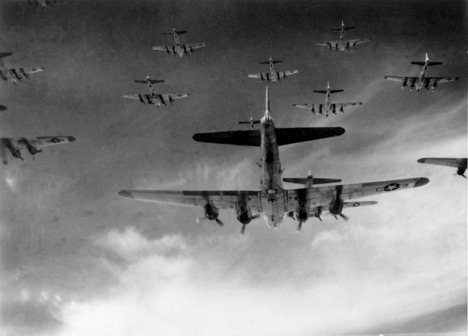
Question: How come we then, had to use planes then?
Answer: We didn’t have any missiles, and ah so we were going to make missiles out of our war weary B-17’s, have a pilot take it off, set it up on automatic pilot, and ah, the automatic pilot would then be controlled by a mother ship flying at a higher altitude, and the mother ship would control the baby ship to the target and dive it in and obliterate it, hopefully. But that never happened (laughs) unfortunately.
Question: So this was our, basically our early day guided cruise missile.
Answer: Right. It was our early day guided cruise missile.
Question: A little Yankee ingenuity?.
Answer: Yeah.
Question: Do you know who came up with the idea, or how they came up with this idea?
Answer: Well the, um, Spaatz, General Spaatz gets credit for coming up with it I’m sure. I’m sure he had inputs from some of his staff and ah, of course Wright field ah, was working on similar projects, and they came in and worked on Aphrodite, of course. And Eglund Air Force Base was a test base there for guided missiles. Ah, guided bombs primarily, we didn’t have any missiles, we had guided bombs, glide bombs. But ah, they were way ahead of us as far as missiles go. We had rockets of course, but uh, they were launched from aircraft primarily or from ships.
Question: You say, were they or weren’t they successful, the Aphrodites?
Answer: They were not successful.
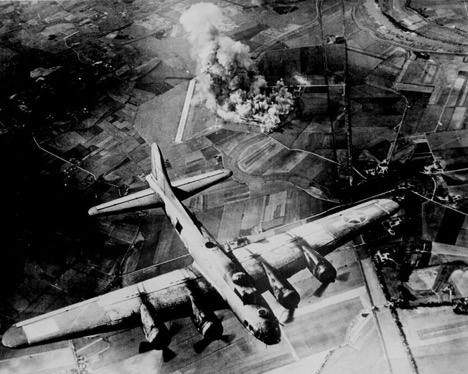
Answer: No, we never did hit one, get one actually on the target. Close, but not close enough (laughs) to play horseshoes even (laughs).
Question: These sound like pretty big fire crackers you’re dealing with.
Answer: They were the biggest detonations in England, or in Europe in World War II. You know, they didn’t use the atom bombs in Europe they used them in Japan. But these were the biggest and most potent explosives used in the European Theatre. And course, couple of them hit in England, at least one of them. One of them hit the ground in England the other one blew up in the air. The rest of them hit near the target or out in the English channel or the North Se
Answer: They went out of control and for some reason, you know, spun into the English channel or the North Sea out of control.
Question: Now what was your duty?
Answer: My duty was to take it off, make take-off, climb up to 2,000 feet, and set it up on automatic pilot, get it fine tuned and fly a rectangular pattern to show, or demonstrate, that the mother ship was in control of my airplane. And I put it in a dive with the automatic pilot and then I armed this load of 25,000 pounds of Torpex manually and electrically. And I bailed out. And ah, I had difficulty getting my elevator control to work so I had to descend a little at a time to 1,200 feet before it would start working right. So by the time I put it in a dive and I got it armed and got out, I was so low that it was only 45 seconds from the time I left the airplane ’til I hit the ground. That didn’t give me much time to maneuver my parachute, and I was trying to maneuver that sucker because I was tracking down big super structure high lines, you know power lines. And I thought sure I was going into them. I said to myself, well fry my hide, here’s the way I’m gonna die (laughs). But I missed it by about six feet or ten feet or something like that.
Question: So once you jumped, how much further was your plane supposed to go?
Answer: Oh, ah, three or four hundred miles, I guess, about three hundred miles I think. The missile sites that were the target were on the Pas De Calais Peninsula of France. Just across the English Channel from, oh I can’t… the white cliffs of Dover, I guess. I can’t remember the name of our departure point, Orfordness, I think. But from Orfordness to the target which was Watten, we had about four missile sites, Watton, Le Moixe, I don’t even know how to pronounce them. They’re in the book but I can’t remember the names of them now. (interrupted, inaudible) But there were four different missile sites that we were after, and missile launch sites. And course we were also thinking of using them on sub pens because bombs hadn’t been effective against the submarine pens but we figured we could fly an airplane into the sub pens and blow ’em up then that would wipe out their sub pens. It was a good idea but we just couldn’t get ’em. (laughs) Couldn’t fine tune ’em, to get ’em into there. We missed, we’d hit short or over or to the right or to the left.
Question: How many did they fly off, how many planes do you know?
Answer: Um… Initially we had ten but I think they added a few, and I, it’s in the book, but I can’t remember. You see, once I left the program, or once all of us left the program then we were through. Once we bailed out we were through with the project unless we wanted to go back and find out. And of course we all did. I kept going back to Nedeshall (Nedingham?) when I’d get a 48-hour pass, I would go to Nedeshall (Nedingham?) instead of going to London because all my old buddies were there and Aphrodite was still going. And I’d get information from them, and that’s the only way ’cause it was top-secret, I couldn’t even tell my crew, my, where I’d been or what I’d been doing. And I never did until 25 years later when the book came out.
Question: Boy that must have been kind of tough, I mean…
Answer: Well it wasn’t tough, you know, you’re sworn to secrecy so you zip your lip (laughs).
Question: But I mean, you’re just are in a conversation and you have to think.
Answer: Yeah I had to, it was hard on me really to have to tell my crew members, my old buddies — hell I was closer to them than anybody, in England at least — to not to be able to explain why I hadn’t been around for the last six weeks. Maybe I had been in jail I guess (laughs), I don’t know, they probably did. I never thought about that much but no, I never could really tell them where I’d been.
Question: Now describe to me, I already heard you (inaudible) little bit, but describe to me getting in the plane you’re sitting there ready to start this up and take off, what it looks like around you and what you have and for cargo.
Answer: Well um, we had to crawl through the navigator’s hatch and um, we had um, a backpack and a chest pack, course we didn’t have them on when we climbed on board we put them on after we got on board. But ah, the ah pilot seat was surrounded by all these wooden boxes of Torpex. And they were wrapped with dynamite cord so they would all go off at once you know, rather than a few at a time and maybe some of them not go off at all. But we had 17 of the boxes scattered strategically through the load that had the arming pins in ’em, just like the pins in a regular bomb, traditional bomb. And ah, you know, you’ve got a pin with a hole in it and a wire going through it and as long as that wire’s in there it’s safe. You can hit it and it isn’t going to go off. But you pull that wire out of there and you hit it, it’s going to go off. Well that, that’s the type and we had 17 of them scattered throughout the load and they were all directed together to a Rube Goldburg handle they had but pulling 17 of those suckers took a brute strength so I had to put my foot up against the bulkhead and really yank on it to get the arming wires out. And then, I armed it electrically. The dynamite cord came up to a panel of tumbler switches, an electrical panel and ah, I threw a switch and there was a little light underneath each tumbler, and they had already tumbled the red light would come on. Well you just forgot about it, you didn’t plug it in because it would blow up in your face if you did. And I think that’s maybe what happened to Kennedy. But then, you throw the switch and if the lights don’t come on then you pull a dummy plug out and plug in the dynamite cord. And then you take your static line from your backpack and hook it on a hook above the navigator’s hatch and put your chest pack on and stick your feet out the navigator’s hatch and away we go. Well it took so long for all this to get done it was only 45 seconds for me, and I learned that from a photo recon ship that was flying along photographing and timing everything.
Question: So where did your plane end up, do you know?
Answer: Yeah it was shot down, coming into the target second time around. The first time around they tried to dive it in and the elevator control didn’t work. So they brought it around to try and do it again, and the second time around well they had an aircraft battery that had all that time to zero in on it, so on the second approach they shot it down. But that’s the last airplane they ever shot down because they were killed from the concussion.
Question: Yeah, that was probably a little surprise to them when they hit that one, eh?
Answer: Yeah, oh yeah.
Question: So even though it didn’t hit its target it still must have done…
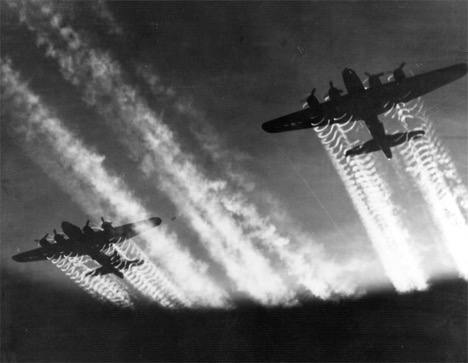
Question: And what year would this have been, I mean this must have been pretty much the tail end of it.
Answer: January 1945.
Question: ’45, yeah.
Answer: Yeah.
Answer: Now the same, the same people, the technical people from Wright -Patterson who were running Aphrodite, wound up being the same people who were flying the radio controlled B-17’s through the atom bomb clouds out in the Pacific nuclear tests. Crossroads was the first Pacific nuclear tests, and the same guys that ah, were working with us on Aphrodite were running that. I ran into them at Clovis, New Mexico in June of 1945 and they said hey, we need you in this outfit because I’d been on Aphrodite. So they got me transferred and General Spaatz signed the order (laughs) transferring me from this 467th bomb group, I think it was, at Clovis to Air Research and Development command so I started training pilots to fly radio controlled B-17’s through the atom bomb clouds and other uses, too.
Question: So they ended up being able to perfect the…
Answer: Yeah, they were able to perfect it and now it’s really perfected, you know. Boy they’ve got pilotless aircraft flying thousands and thousands of miles doing photo recon. It’s the most effective use of it today. But all this started out with Aphrodite, see?
Question: Well I heard you say something about TV cameras.
Answer: Yeah, yeah.
Question: What was that?
Answer: Well ah, it was either Eglund or Wright field had been testing this, putting television cameras through the nose of the baby so we started testing it there during the month of July. I flew several test missions working on developing this television camer
Answer: See the control pilot and the mother ship had his TV receiver right there like where the bomb site would normally be and his control box there also, and the ah, transmitter was in the nose of the baby ship. It was looking out at the terrain so that, the control pilot was seeing where he was going, where the baby was going. And trying to line it up on the target by television. Which eventually, worked out fine, several years later, but it didn’t work out worth a damn in 1944. It wasn’t, TV wasn’t developed enough at that point. But it was a good idea, you see, and it has progressed now to where we see instantaneously what these astronauts are doing in their capsules, couple a hundred miles above the earth, or on the moon even. We get, we look at them on television now walking on the moon and back in ’44 they didn’t have it developed (laughs) you know, that good. But it was under development, you see, it was under development then. And it had just progressed from that to the present day sophistication.
Question: Must be kind of neat to be able to look back and think you were kind
Answer: ..
Answer: Yeah, I was a part of that, you know (laughs). Yeah it really, I do, I swell with pride in looking back and thinking, you know what? I was a (laughs) one of those back then.
Question: Well I wonder how many other little World War II secrets there were that had…
Answer: Oh. All kinds of them I’m sure, ’cause I’m, the more reading you do the more you find out, mysterious things that went on that you never dreamed or you never knew about. And there again you say my God, I was right there, I was right next door and I didn’t know it was going on (laughs).
Question: That’s, I’ve asked a lot of the Vets.
Question: Did you know at the time you were a part of history or do you only realize it…
Answer: Oh no. I was just doing my job, getting a little excitement (laughs).
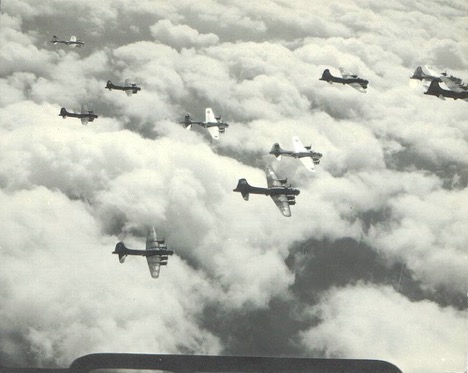
Answer: I knew I was doing something that was new, and that makes it exciting you know. When you’re doing something for the first time it’s ever been done. Or developing something that needs developing. You get a sense of pride from that, you know.
Question: Were you just a kid pilot, were you pretty young?
Answer: Oh no, I was, I was an old man (laughs). I was 26.
Question: Oh that was probably an old man at 26.
Answer: Yeah, yeah I’ve, there were kids 18 and 19, you know, on my crew.
Question: Did they, you had enough age and wisdom, when you sat down in this plane and you have all this explosive wiring back here, which I assume is not as stable as it could be…
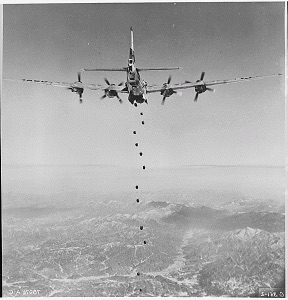
Question: Well what was going through your mind, or was it just…
Answer: Well, it was a concern. I’d say what if that stuff shifts you know, or, but not enough to really worry about it. You gotta, I figure, boy old Joe better tie that stuff down (laughs) good, you know, or I’ll have his ass (laughs), you know. You got to depend on Joe to do his job.
Question: You got to get back to get his ass though.
Answer: Yeah, yeah, you got to get back there. But you think about it. Especially, you know, when I turned the switch on for the, ah, converter and those sparks were flying that close to the dynamite cord, boy that got my attention (laughs) I’ll tell you. My hair on my neck kind of stood up when I saw that (laughs).
Question: So it’s pretty interesting because they talk about Yankee ingenuity in World War II, this was a real good example…
Answer: Yeah.
Question: And you didn’t succeed but yet it was trying to find something to do with what we had and…
Answer: It was a stepping stone to something better. And ah, we have taken what we learned from that and developed something really worthwhile, something that does work every time. Or almost every time anyway.
Question: So where were you when the war ended?
Answer: I was at Chatham Field, Georgia, flying B-29’s. Yeah it was my daughter’s birthday, August 15th. Of course, she was one-year-old on August 15th, when I…
Question: Do you think that there’s a message from World War II for future generations?
Answer: Yes, I think so. Together we stand and divided we fall. ‘Cause boy we really pulled together, it just, I can’t believe how well the whole nation pulled together to win that war. ‘Cause that was a bugger, you know, it was really tough on all Theatres and ah, the women who took those jobs in those aircraft factories and that did all those jobs, the nurses, the, that took the place of the, did the jobs that the men normally do. But ah, boy we couldn’t have won without it. But I just think it’s so wonderful the way everybody pitched in and did it together. Now that’s kind of hard to find nowadays ’cause you get a bunch of people together to try to do something, you got just that many or more hagglers who are harassing you and trying to make it more difficult.

Answer: Hah. I burst with pride. And I cry when I see it burn.
Question: I just interviewed a vet that was in the South Pacific and he said that’s an interesting dilemma because basically the same thing, except he talked about, you know, I fought for their freedom to be able to do that .
Answer: Um hm.
Question: To be able to burn that flag.
Answer: Yeah.
Question: See that’s a real weird dilemma to think about.
Answer: Yeah. I guess. But I’d still like to kick the ass of the guy that does it.
Question: Do you think that this generation understands what freedom is? Not your generation, mine and younger, do we have a concept of what we have?
Answer: Um, I don’t think you really do. I think they think it’s a, kind of like the weather, you know. Freedom comes and goes, but I don’t know I don’t like to say anything against younger generations as we call it. But I surely do think that we can look with pride at our togetherness and the job we did in winning this freedom. And ah, we need more people like that as the years go on and on and the generations come and go.
Question: What do you think the history books have left out of World War II?
Answer: Gee, I don’t know if they left out anything. I feel like they’ve done a good job. But I like what I’m seeing now, trying to get a little more of it person-to-person you know. It kind of gives a kick to old guys like me for somebody to be interested in what we did 53 years ago.
Question: I was going to say, it only took us 50 years to ah…
Answer: To appreciate it. That’s, that’s kind of amazing, that it took all this time to get patriotic again (laughs).
Question: What ah, um, when did you go into the service, at what point in the war?
Answer: June of ’42. Ah, I was working for the post office in Fort Sill, Oklahoma, on Pearl Harbor day, December 7th. And I was having lunch in my car when I heard on the radio that Pearl Harbor had been attacked. But I had always wanted to be a pilot and especially an Army pilot. And um, so I couldn’t wait to see if I couldn’t get into pilot training. And I made it so, I ah, I entered the civilian pilot training program first. And um, on June 5th, I think it was, I got my private pilot’s license, graduated from that civilian pilot training program, and uh took my Air Force exam, and ah, passed it, and I was sworn in June 5th, 1942 as a private in the Air Corp, Air Corp Reserve, waiting to be called active duty as an aviation cadet. And um, November 11th, Memorial, or Armistice Day they called it, I was called to active duty and went to Santa Anna, California for my pre-flight training, they call it basic training now. And then I went to primary flight school in Santa Anna, California, I think it was in February of ’43. And then La More, California for basic and then Douglas, Arizona for advanced. And I ah, got my commission and my pilot wings, first of October 1943. I was in pilot class 43-I. And that’s when I realized my life’s ambition, up to that point anyway.
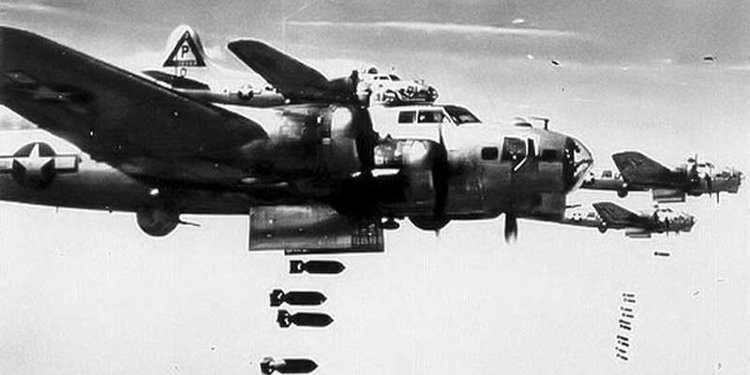
Answer: And then I, then they sent me to Roswell, New Mexico to B-17 training. So I finished that training in December, December 19th, and got on a train to Salt Lake City, Utah to pick up my combat crew and all my equipment. And then I went to Ardmore, Oklahoma after I, I and my crew when to Ardmore and went through combat crew training for B-17’s, and I was the aircraft commander, and pilot, I had a co-pilot, bombardier, navigator, and six gunners. Had a top turret gunner, who was an engineer, a ball turret gunner, radio operator gunner, and a left and right waist gunner and a tail gunner. So ten of us, and we went, we stayed together from then until we completed our combat tour. When I went on Aphrodite, instead of just sitting around and not flying, they had them fly with other pilots in the squadron while I was on temporary duty. And so they got ahead of me in missions. But after I left Aphrodite, came back, and I got my crew back, and we finished their tour first, and then I finished my tour November the 16th of ’44, and got promoted to captain the same day. Also I was the only one that got back from the mission that day. The weather was so bad that ah, all the other airplanes landed at other bases, in England, and France and Belgium and all over. But boy, nothing was going to be keeping me back (laughs) that day. So I made my first pass and ah, I wasn’t lined up well enough for the runway. It was foggy, so foggy it was pathetic and you could hardly see anything. But I could see the runway lights enough to know that I couldn’t make it, so I poured the coal on to go around again and boy, another B-17 coming in from the opposite direction. So we just barely missed each other, and he gave up and went somewhere else, but I came around and I made it the second try. But I was the only one that got back that night so I had nobody to celebrate with (laughs). But I celebrated the next day, because the next day, my squadron commander came over and pinned my captain bars on me, and I had to buy drinks for the whole bar. There went my first month’s pay raise (laughs).
Question: Did, ah, did all your crew make it back?
Answer: Yeah, we all made it back. Nobody wounded, or no purple hearts. We had lots of air medals and I had the distinguished flying cross from Aphrodite. Ah, I guess my records show that I have a, um an oak leaf cluster to my distinguished flying cross. But it never was awarded so… But it’s in my records somewhere.
Question: When, did you stay in touch, I mean I don’t know if all of them are still alive?
Answer: Yeah we’ve ah. No, I’m the only one that I know of who’s still alive. I kept in touch with my co-pilot and my bombardier. My co-pilot died last ah, I think it was September of last year, and my bombardier died in March or April, March I think it was, of this year.
Question: So what do those guys mean to you?
Answer: Oh, they…
Question: In, in, how I ask this is, on your time line of life World War II was this very, very short time…
Answer: Um hm.
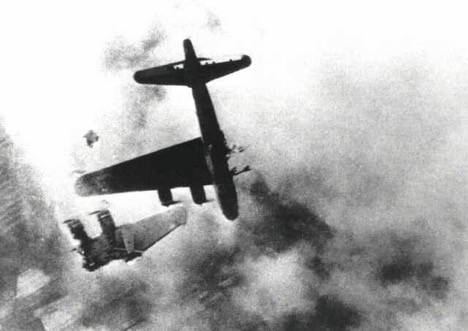
Answer: I have found that, I don’t know, I don’t know what there is about it but even people I’ve talked to, that was only nine or ten months of my whole life, but I remember things that happened during that ten months more vividly than any other period of my life. And I think it’s because we were getting shot at, you know (laughs) and I think that makes you remember being missed, at least, because I’ve had some really close calls. God I have a couple pieces of flak that I brought back, and one of them was right in the windshield, right in front of my face, but it stuck in the windshield, it would have hit me right in the face, and another one that came it and just missed my elbow and hit the top of the cockpit and fell back down. So I brought those two pieces of flak back with me. I have them mounted in my shadow box (laughs). But as far as how I felt with those two guys it, you feel like brothers, really close. Yeah, they… I was sure happy to get to, I got together with ’em at least once every two years, my bombardier. But my co-pilot, he came up to visit me a couple of times extra, other than just at the reunions. But I’m the only one that I know of still living. I’m the only one of my family still living so I’m the patriarch (laughs). I was the eighth child and all my brothers and sisters, gone. So I’m happy to be here, and happy for what health I have. You know, I used to fill out these questionnaires you know, how do you rate your health, I always says very good or excellent, lately I start looking at that word fair or good (laughs) or what. I don’t know whether to say fair or good. And when they say what’s wrong with you I say arthritis, you know.
Question: Well I say, thank you very much.
Some incredible stories of life in the B-17 Flying Fortress and life during World War II. Jimmy Doolittle’s story is also iconic.
Check out part two of this Veteran’s World War II war stories. Or check out this story about Admiral Stockdale, a POW for seven years in Vietnam. https://thefrontlines.com/story/admiral-james-stockdale/
(Courtesy of WWII Voices in the Classroom, www.wwiihistoryclass.com)
The Frontlines uses referral links cover the web hosting, research and gathering of stories to preserve military history and humor. The items linked to are my personal favorites of stuff or things I have read over the years. Thank you for your support!
Popular Products
-
Fastest Swimmer – Unisex Shirt
$20.00 – $26.00Select options This product has multiple variants. The options may be chosen on the product page -
Rescue Swimmer Definition Hoodie
$42.00 – $54.00Select options This product has multiple variants. The options may be chosen on the product page -
Pay Attention in Class
$19.50 – $28.00Select options This product has multiple variants. The options may be chosen on the product page -
Warrant Officer (Beret version)
$19.50 – $28.00Select options This product has multiple variants. The options may be chosen on the product page

